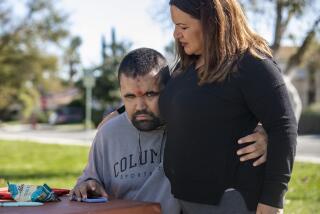Odds Have Improved Because of Advances in Treatment, Coma Centers : Brain-Injured Patients Have Become a Growing Rehabilitative Concern
- Share via
ERIE, Pa. — The message stitched on a blue handkerchief tacked to a bulletin board in Steve Eaton’s room reads, “Expect a new miracle every day.”
It is a message of hope for the family of the 27-year-old, brain-injured construction worker, in the midst of a slow, painful recovery following a seven-month coma.
“I’m going to walk out the front door,” Eaton said recently in a slow, halting voice from his wheelchair at the Lake Erie Institute of Rehabilitation.
His legs were smashed, his brain pounded, when he fell 20 feet from a scaffolding to a concrete foundation in June, 1984. The scaffolding had collapsed due to loose nails.
Odds Are Improved
“I shouldn’t have gotten hurt in the first place. But you can’t go back and fix things,” said Eaton, a father of three from Findley Lake, N.Y.
“I might not be able to walk as good as I used to be. But I’m going to.”
A decade ago, the chances of even surviving his injuries, let alone walking, would have been slim, according to experts.
They say patients’ odds have improved in part because of advances in treating traumatic brain injuries and the growth of coma centers like the Lake Erie Institute. Mandatory seat-belt laws and campaigns against drunk driving are paring the number of victims.
Longest Coma Is 34 Years
An estimated 140,000 Americans are expected to die of head injuries this year, half of them as a result of traffic accidents, according to Heidi McCrory of the National Head Injury Foundation Inc., a nonprofit foundation in Framingham, Mass.
Roughly 700,000 more will be hospitalized. About 70,000 of them, mostly young men who fall into comas, will be left with little or no ability to remember, reason or speak.
While the longest coma on record lasted 34 years, only 3% to 5% of all cases lead to what doctors call persistent vegetative state, in which patients’ eyes are open but unresponsive, and hope fades. Karen Ann Quinlan died in 1985 after 10 years in such a coma.
A patient suffers coma, or loss of consciousness for an hour or more, when his or her brain is severely injured, usually in the brain stem or nerve fibers.
Difficult Problems Remain
Because of the damaged fibers, information cannot be transmitted to the part of the brain responsible for conscious activities, such as talking and moving. This part of the brain becomes isolated from the rest of the brain, resulting in unconsciousness.
“There’s more attention, more recognition of the fact that there are things that can be done” to help those emerging from comas, said Dr. Sheldon Berrol, chief of rehabilitation services at San Francisco General Hospital.
Nonetheless, difficult problems remain for victims and their families.
Although most comas last less than a month, the recovery process still takes years, longer than many institutions or insurers are willing or able to wait.
Forgotten and Forsaken
“We’re taking these patients from the roadside, only to leave them by the wayside a year later,” said Dr. James A. Mikula, the Lake Erie Institute’s director of program development.
Forgotten and forsaken by society, the brain-injured for decades were shunted off to schools for the retarded, mental institutions or geriatric nursing homes to quietly live out their lives. Care was less than adequate and rehabilitation was virtually nonexistent. Those with little or no resources were cared for at home.
More than 400 programs care for such patients now, McCrory estimated. The problem is getting patients into them and getting the government or society to pick up the high costs, officials say.
“Only one in 20 head-injury survivors gets care and rehabilitation. Another 19 are sitting in nursing homes, they’re at home, they’re struggling on their own, they’re street people,” McCrory said.
‘Like Watching Tree Grow’
Improved emergency care and neurosurgical advances are keeping more head injury patients alive, but, Mikula asked, “Now what do we do with them?”
At the 122-bed Lake Erie Institute, doctors, nurses and therapists are doing all they can.
The costs of patient care and therapy at the institute, running up to $600 a day, generally are covered by workers’ compensation, Medicaid, or private health or auto insurance.
“It’s like watching a tree grow,” Mikula said of patients’ recovery.
“Nobody ever sits up and asks for a hamburger” when emerging from a coma, said Dr. Robert Sawicki, director of neuropsychology at the institute.
Bombards Their Senses
To draw patients out of coma, the institute bombards their senses by stroking their faces and arms with silk and sandpaper, ringing bells and blowing whistles, surrounding them with mementos from home, and pushing them on padded swings.






